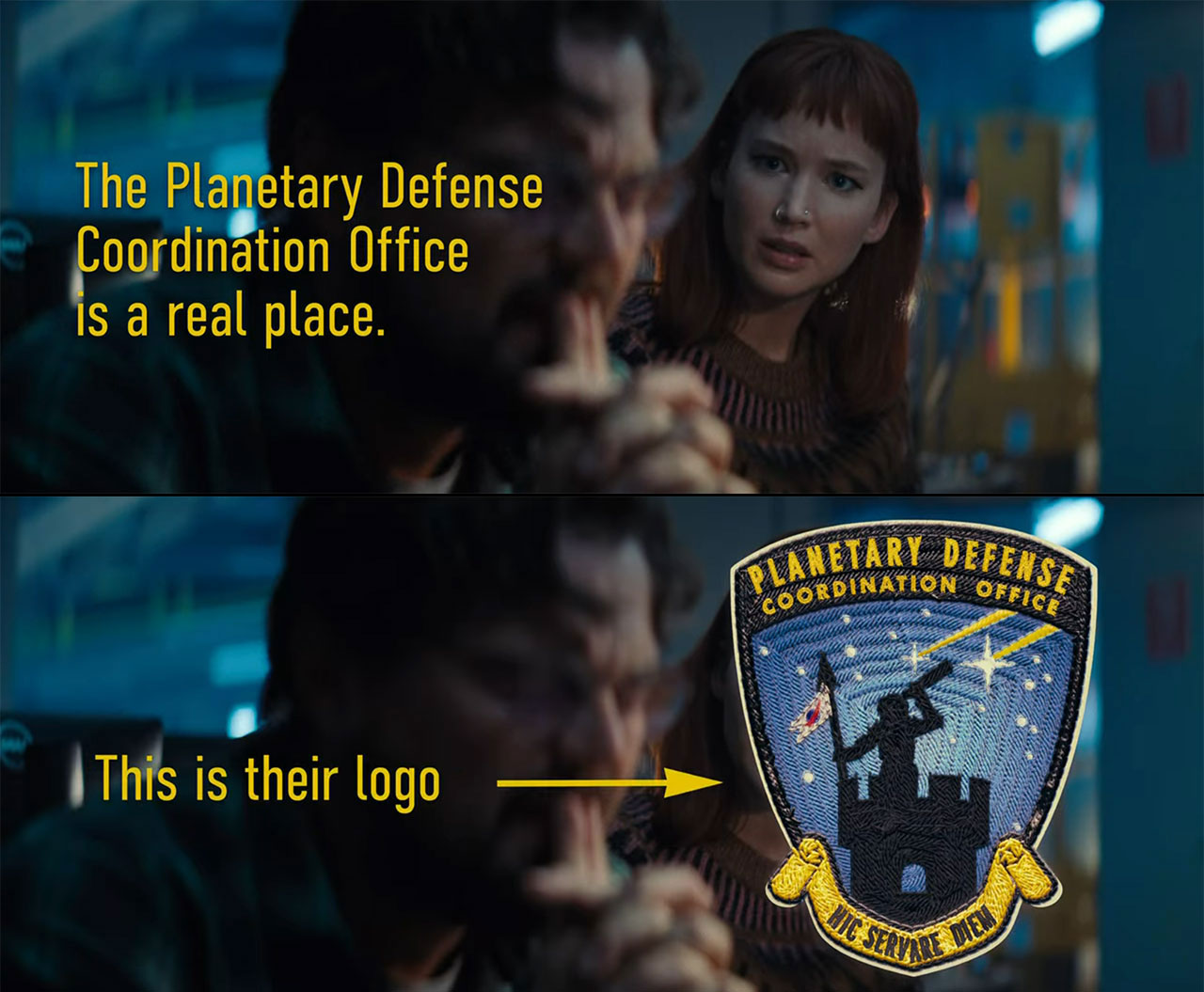How a real NASA patch anchors Netflix's 'Don't Look Up' in reality

"Talking about your office, the Planetary Defense Coordination Office, you've got the patch there. In fact, I was observing a little Latin phrase at the bottom, what does that say?"
"'Hic Servare Diem,' which means 'Here to save the day.'"
That exchange, between a NASA commentator and a scientist in the agency's planetary science division, took place during a live broadcast leading up to the launch of NASA's first mission to deflect an asteroid. But it could have easily fit into the new, satirical science fiction film, "Don't Look Up," which lands on Netflix on Friday (Dec. 24).
In fact, the same patch not only appears in the movie, but it is highlighted on screen to emphasize that it is indeed real — one of only a few real-life details that are not stretched to the point of (hopeful) ridiculousness to serve the film's tone and multi-level message.
Related: The greatest comet close encounters of all time

"I am on hold. She's calling a Dr. Oglethorpe, who is that?" astronomy professor Randall Mindy (Leonardo DiCaprio) says in a scene not long into the two-hour film.
"Dr. Oglethorpe, head of the Planetary Defense Coordination Office," replies his grad student, Kate Dibiasky (Jennifer Lawrence), after looking up the name. "Is that a real place?"
Get the Space.com Newsletter
Breaking space news, the latest updates on rocket launches, skywatching events and more!
The movie then pauses to break the "fourth wall" and answer the question.
"The Planetary Defense Coordination Office is a real place," an expository intertitle reads, briefly interrupting the movie to explain. The screen then displays the patch. "This is their logo."
The patch depicts two "shooting stars" crossing the night sky over an astronomer standing atop a castle tower. The figure is holding a NASA flag on an arrow-tipped spear in one hand and a telescope in the other.
"This is obviously a science fiction movie, right? We take off into sci-fi territory very quickly, because, obviously, we don't know of a gigantic comet that's about the smack into Earth. That isn't real. So thankfully, that's the great news, right?" Amy Mainzer, an astronomer and climate change scientist who served as the technical advisor for "Don't Look Up," said in an interview with collectSPACE.com. "But the Planetary Defense Coordination Office is very real, and it really didn't exist until fairly recently."
NASA established the Planetary Defense Coordination Office in January 2016 to organize planetary defense efforts across NASA with other U.S. agencies and with international partners. The office also administers NASA's Near-Earth Object Observation Program, which dates back to 1998.
"You would think that it would be kind of a no-brainer to have a comprehensive program to search for asteroids and comets, but even that's been a long time coming," said Mainzer. "People have been working on it for a long time, but I would say with very modest resources, considering what's required to actually go out and and solve this particular problem."
"So we are finally getting to the point where we are undertaking a much more comprehensive survey of these objects," she said.
Mainzer is the principal investigator for NASA's Near-Earth Object Wide-field Infrared Survey Explorer mission, a space telescope that searches for Earth-approaching asteroids and comets. In March 2020, Mainzer and her team discovered the comet NEOWISE, the brightest comet in the northern hemisphere since Hale-Bopp in 1997. The Earth-threatening comet in "Don't Look Up" is loosely based on that discovery.
"I did a lot of work on designing an orbit and actually modeled some aspects of the comet in the movie after Comet NEOWISE so that it would be somewhat realistic," Mainzer said in an interview with Netflix. "I tried to pick something that fit the needs of the film, but was also not too far from reality."
"Don't Look Up," directed by Adam McKay, is intended to be viewed on multiple levels. In one sense it is black comedy; on another it is the story of Earth's reaction to an incoming threat from space. On yet a third level, it is a commentary on our responses to climate change, the COVID-19 pandemic and other pressing issues of today.
Related: The 5 most realistic space movies

"Part of the reason I was excited to be involved with this movie is because it has an important message to say about the importance of science in our everyday lives and in our society," Mainzer told collectSPACE. "Science is about what we have proven through evidence to be objectively true."
"We need to make decisions based on science. It is important because if we don't, we are not going to end up with the best possible outcomes for a whole host of different problems, whether it is the threat from asteroids and comets or climate change or extreme weather or the pandemic," Mainzer said. "We have to make scientific decisions and it could not be more important than it is to do that now."
Hence the inclusion of the Planetary Defense Coordination Office and its real patch in the film, as it is a subtle reminder to the audience that "Don't Look Up" is not just about a Hollywood-invented plot point.
"This movie points out how hard it is sometimes for people to grapple with problems that are difficult to visualize. You can't see with your own two eyes a CO2 [carbon dioxide] molecule or a methane molecule, you can't see a virus with your own eyes, but you still have to pay attention to them and they are very real and they can have very severe consequences if we don't deal with these things appropriately," said Mainzer. "So the comet is an allegory for a lot of these kinds of challenges that we face as a society — long-term problems that can have big impacts."
"Don't Look Up," written and directed by Adam McKay and starring Jennifer Lawrence, Leonardo DiCaprio, Meryl Streep, Jonah Hill, Cate Blanchett, Tyler Perry, Ariana Grande and Ron Perlman, opened in limited theaters on Dec. 10 and begins streaming on Netflix on Dec. 24.
Follow collectSPACE.com on Facebook and on Twitter at @collectSPACE. Copyright 2021 collectSPACE.com. All rights reserved.
Join our Space Forums to keep talking space on the latest missions, night sky and more! And if you have a news tip, correction or comment, let us know at: community@space.com.

Robert Pearlman is a space historian, journalist and the founder and editor of collectSPACE.com, a daily news publication and community devoted to space history with a particular focus on how and where space exploration intersects with pop culture. Pearlman is also a contributing writer for Space.com and co-author of "Space Stations: The Art, Science, and Reality of Working in Space” published by Smithsonian Books in 2018.In 2009, he was inducted into the U.S. Space Camp Hall of Fame in Huntsville, Alabama. In 2021, he was honored by the American Astronautical Society with the Ordway Award for Sustained Excellence in Spaceflight History. In 2023, the National Space Club Florida Committee recognized Pearlman with the Kolcum News and Communications Award for excellence in telling the space story along the Space Coast and throughout the world.











